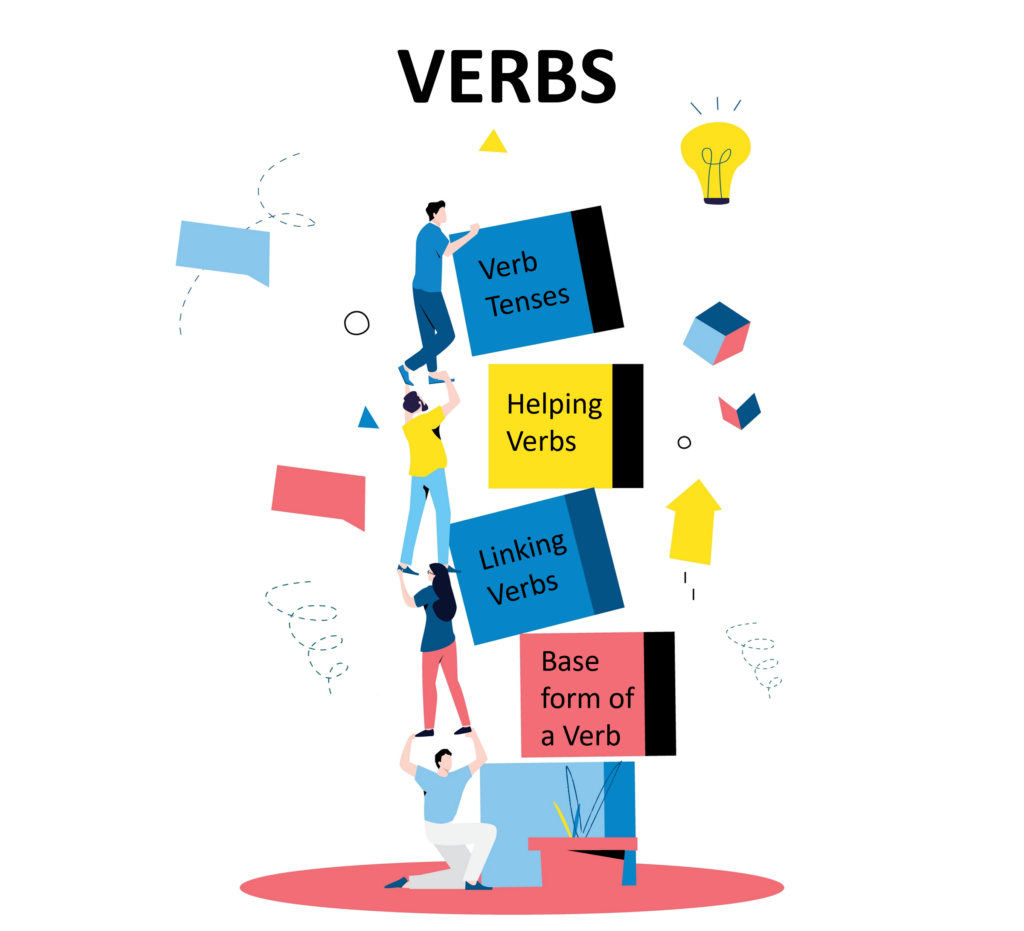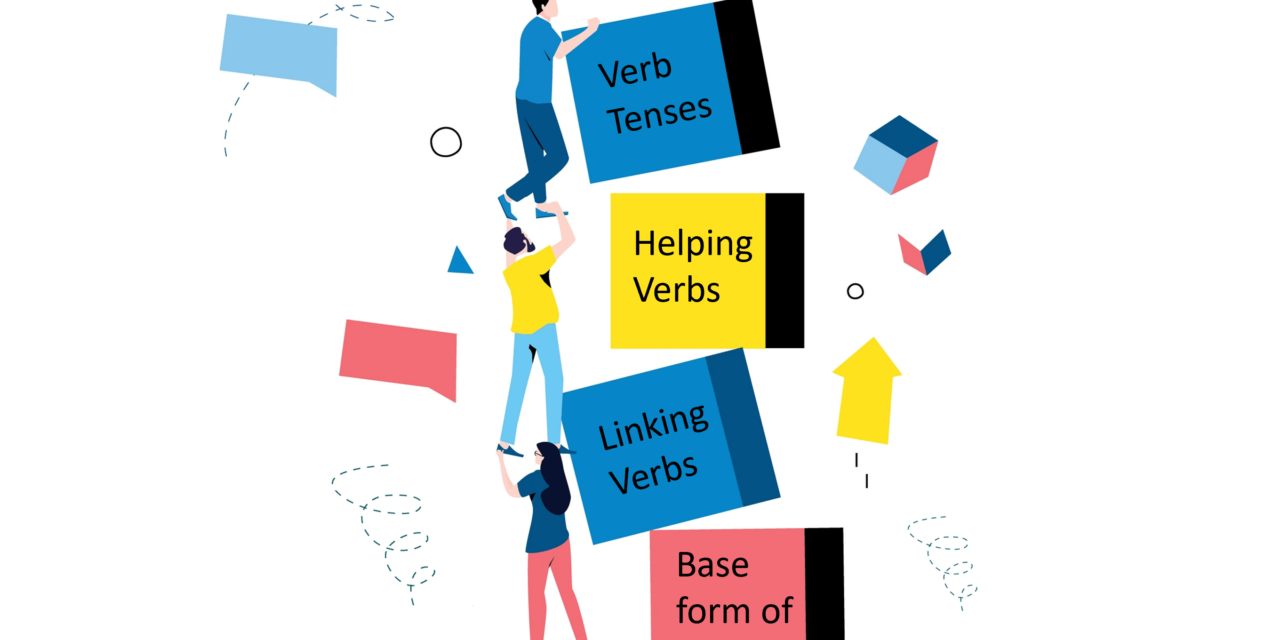Verbs are an integral part of a sentence, and verbs-related errors, such as subject-verb agreement and verb tense errors, are very commonly tested on the GMAT. The goal of this article is to help you understand the basics of Verbs and the various Verb tenses that are commonly tested on the GMAT so that you can build a strong foundation to tackle those 700+ level questions with ease. We shall provide a detailed explanation of some of the most basic concepts about verbs such as what are verbs, what are linking and helping verbs, what is the base form of a verb, and the different verb tenses. We shall also demonstrate to you how some of the verb-related errors are tested on the GMAT with the help of a few examples.

What are Verbs?
Verbs are a necessary component of all sentences. A sentence is not complete without a verb and its subject. Typically, verbs denote the action performed by the subject. For example:
- The clock ticks all day long.
“ticks” is an action verb here as the clock us the doer of the action. The clock does the action of ticking all day.
- The beggar sat down by the side of the road.
“sat down” is the action verb here, and the doer of this action is the sentence’s subject – “the beggar”.
On several occasions, verbs, instead of presenting the action of the subject simply connect the subject to some other additional information about the subject. In such cases, they are called linking verbs. Let us understand them in detail:
What are linking verbs?
Verbs can also connect or link the subject to additional information about this subject. Such verbs are called linking verbs. For example:
- My mother is a great cook.
The verb “is” does not denote an action word. But it connects the subject of the sentence – “My mother” – to some additional information about her.
- Richard seems sad today.
The verb “seems” does not denote any action word but it connects the subject of the sentence “Richard” with the additional information that he looks sad.
- After getting the news that she had made it to her dream college, Rachael became very happy.
The verb “become” again does not denote any action but it connects “Rachael”, the subject of the sentence, with the remaining information in the same.
How to recognize linking verbs?
If you can replace a verb in the sentence with is, am, or are and the sentence still makes sense, then those verbs are linking verbs.
For example:
- The question looked difficult to everybody in the class.
Let’s replace “looked” with is – The question is difficult. This makes all sense. Hence “looked” is a linking verb in this sentence. Furthermore, it will not make sense to consider the question actually performing the action of “looking”. The sense of the sentence here is that the question actually appeared difficult to everyone in the class.
- Josh looked at the question until he solved it in his brain.
So can we say, Josh is the question? Not at all. Hence, “looked” in this sentence is an action verb. Josh is actually performing the action of “looking”.
Now that we have a basic understanding of what verbs and linking verbs are let us understand another important form of a verb- its base form.
Base form of a verb:
The base verb is the simplest form of a verb without any special ending. It is the form of the verb used into + verb forms without “to”. For example: dance, do, cook, sing, play, read, etc.
Base verbs are used with I, you, we, they, and plural subjects.
- I cook food.
- You dance well.
- You play all the time.
- They do the work.
The singular form of verbs can be determined by adding “s” or “es” to the base verb. For example:
- She cooks food
- She dances well
- She plays all the time
- He does the work.
Understanding of base form of verbs is very important. Once you have this understanding, you will get a good handle on verbs by understanding how different tenses work and how you can write verbs in different tenses.
Verbs are one the most widely tested concepts on the GMAT SC. We cover all the concepts required to ace the GMAT SC, starting from the foundations of GMAT grammar in the e-GMAT SC course. We also have 400+ GMAT level practice questions with detailed solutions. Begin your GMAT preparation with our free trial today!
Helping Verbs (Auxillary Verbs):
A verb can consist of more than one word. In such cases, there is one main verb and the rest are called auxiliary or helping verbs. Following is a list of the auxiliary verbs:
is, are, am, was, were, has, have, had, be, do, does, did, must, being, has been/have been/had been, can/could, may/might, will/would, shall/should
Let us take a few sentences to understand helping verbs:
- The president is deliberating on the issues of economic crisis.
In this sentence, “deliberating” is only part of the verb. It alone does not form a verb in this sentence. The preceding helping verb “is” makes them together the verb.
- Mike has been working on his project since yesterday.
In this sentence, “working” is only part of the verb. But the complete verb here is “has been working” in which “has been” are the helping verbs without which the -ing form of the verb cannot be regarded as a verb.
Also, notice that when we use do/does/did, it is always followed by a base verb. And when that happens, the number of the helping verb depends upon the number of the subject.
For example:
- The flower does not bloom well in windy weather.
Notice that “the flower” is the singular subject. That is why the helping verb used for this subject is singular “does”. Since we have already used one singular verb in the sentence, the verb that follows the helping verb is in the base form. Even if the subject is singular, we cannot say “does not blooms”.
Now if this sentence is written without the helping verb, then the main verb will follow the number of the subject. For example:
- The flower blooms in windy weather.
Likewise, in past tense sentences, if the helping verb “did” is used, then it is also followed by the base verb. We cannot use the past tense of the main verb with “did”. For example:
- The flower did not bloom in windy weather. Correct
- The flower did not bloomed in windy weather. Incorrect
Now that we understand the base form of verb and the helping verbs, let us understand how the tenses govern the timing of the action presented by the verb.
Verb tenses tested on the GMAT:
Every verb has two important characteristics: The action itself and the timing of the action. This timing of the action is denoted by the verb tense.
Sound understanding of verb tenses is very important to answer GMAT Sentence Correction questions. Typically in a sentence, we must express verbs in consistent verb tenses. The appropriate tense is determined based on the context of the sentence and, accordingly we must use the correct verb tense. As an example, if the sentence states a fact in the present context of time, then we must use simple present tense. Thus, the following two things are very important to address verb-related errors in sentence correction questions:
- Understand the meaning of the sentence to determine the timing of the actions
- Apply the knowledge of verb tenses – which verb tense expresses what timing
Let us see this in action with an example:
Now Mary likes young children, but there is a time when she cannot tolerate their tantrums.
This sentence has 3 verbs as marked. The sentence begins with the word “now”. Then there is the word “but” indicating that there is a contrast in this sentence. Now, as we read the sentence, we understand that the author presents the current state of Mary’s liking towards young kids. This is presented using simple present tense for “likes”.
Then as we read ahead, we see that the author presents some information about the time when Mary could not tolerate their tantrums. Now clearly, NOW Mary likes kids. BUT in the past she did not like them. Thus the verbs after “but” denote actions of the past time frame and hence must be presented in simple past tense in this case. Thus, the sentence should be corrected as follows:
Now Mary likes young children, but there was a time when she could not tolerate their tantrums.
There are three major tenses in the English language:
- Present tense
- Past tense
- Future tense
We can further divide these three tenses into subcategories such as simple, continuous, and perfect tense. Let us understand each of them in detail:

Present tense:
The verb that refers to present time is called the verb in Present Tense. For example:
- Harry goes to a wizard school.
- Ria is working hard on her project.
We can further divide present Tense into four sub-categories:
Simple Present Tense:
This tense is used to present general information or universal truths that hold true for all times. It is also used to express habitual actions. For example:
- The sub rises in the east. (Universal Truth)
- My mother always prepares breakfast for me. (Habitual Action)
- The company gives handsome perks to diligent employees. (General Information)
Present Progressive/Continuous Tense:
This tense is used to show an action that has begun, is still happening, and is not finished yet. Since the action is still continuing and not over, it is called the continuous tense. Generally, the present continuous tense is derived by adding “ing” to the base verb. A point to remember here is that only the verb-ing word does not make the continuous tense. The verb-ing word must be preceded by a present tense helping verb to make the verb in present continuous. Let’s take examples here:
- Stella is explaining her project to the investors.
- The managers are looking for people for a numbers of vacant posts in the company.
- I am cooking dinner early so that I can watch my favorite show.
The verbs in all the above three sentences are “is explaining”, “are looking”, and “am cooking”. Notice that if we used only “explaining”, “looking”, or “cooking” in these sentences, they would not qualify as verbs in the absence of the helping verbs “is”, “are”, and “am” respectively. These helping verbs actually show the tense of the action. Hence, in present continuous tense, the verb-ing word MUST BE PRECEDED by is/are/am.
Present Perfect Tense:
This tense is used to denote two kinds of action, action
- that has finished in the immediate past. For example:
- She has just finished her breakfast.
- They have just gone out.
- that has finished in the past but the effect of which continues in the present. For example:
- The recession has made many people jobless.
- Many students have applied for travel concession.
- whose time is not given and is not known.
- Johnny has visited Europe.
- have read all the Harry Potter books.
- that started in the past and is continuing up to the current moment. Such sentences are generally written with “since” or “for phrases”.
- I have known him since 1980s.He
- has been sick for the last two weeks.
The present perfect tense verbs are written with “has” or “have”. However, these words in themselves are not present perfect verbs. To be so, they must be followed by the verb in its participle form. The verbs in all the above mentioned examples follow this structure. So “has” or “have” together with the participle form of verb makes the present perfect tense.
If “has” or “have” is used just by itself and is not followed by a verb in its participle form, then it works as simple present tense verb.
- I have lots of chores to finish. (Simple Present Tense)
- He has your book. (Simple Present Tense)
Present Perfect Continuous Tense:
This tense is used to present an action that started sometime in the past and is still continuing in the present. This tense is a mix of present continuous and present perfect tense and hence uses the following structure:
- Joe has been sleeping since morning.
- They have been playing all afternoon.
Past tense:
The verbs that denote that the actions took place in the past are said to be the verbs written in past tense. For example:
- John went to school yesterday.
- Gina prayed before she slept.
Past Tense can be further divided into four sub-categories:
Simple Past Tense:
This tense is used to present general information about the actions that started in the past and finished in the past as well. We also use this tense to talk about past habits. For example:
- Many freedom fighters gave their lives, fighting for the independence of their country.
- Mary practiced for 12 hours every day before her first performance.
Past Progressive/Continuous Tense:
This tense is used to show an action that was happening in the past. The time of the action may be or may not be indicated.
Like the present continuous tense, the past tense is also derived by adding “ing” to the base verb. A point to remember here is that only the verb-ing word does not make the continuous tense. The verb-ing word must be preceded by a past tense helping verb to make the verb in present continuous. Let’s take examples here:
- Roy was playing football with his younger brother.
- The managers were looking for people for a numbers of vacant posts in the company.
- The power went off when I was reading.
The verbs in all the above three sentences are “was playing”, “were looking”, and “was reading”. Notice that if we used only “playing”, “looking”, or “reading” in these sentences, they would not qualify as verbs in the absence of the helping verbs “was”, “were”, and “was” respectively. These helping verbs actually show the tense of the action. Hence, in present continuous tense, the verb-ing word MUST BE PRECEDED by is/are/am.
Past Perfect Tense:
This tense describes action that was completed before a certain moment in the past:
- I had met Julia some 20 years ago.
- My great grandfather had given this watch to my grandfather.
The past perfect tense verbs are always written with “had”. However, this word in itself is not a past perfect verb. To be so, “had” must be followed by the verb in its participle form. The verbs in the above mentioned examples follow this structure. So “had” together with the participle form of verb makes the past perfect tense.
If “had” is used just by itself and is not followed by a verb in its participle form, then it works as simple past tense verb.
- I had your book but not anymore. (Simple Past Tense)
- The team had great respect for its former coach. (Simple Past Tense)
Past Perfect Continuous Tense:
This tense is used to present an action that started sometime before a certain point the past and continued up to that time. This tense is a mix of past continuous and past perfect tense and hence uses the following structure:
- When Prof Roy joined the institute, Prof Sen had already been teaching there for six years.
- At that time, he had already been working on his fifth book for three months.
Future Tense:
In order to talk about the events that are to take place sometime in the future, we use Future Tense. We use “will” or “shall” to indicate the future tense.
- Ria’s performance will take place sometime next month.
- Tomorrow, you will get your flu shot.
As is the case with Present and Past Tenses, We can also divide future Tense into four subcategories.
Simple Future Tense
This tense is used to talk about the general events that will take place in the future. We also use future tense for events that we think or believe will take place in the future.
- Mary will perform well in her singing recital.
- I think John will participate in the annual marathon this time.
Future Progressive/Continuous Tense
This tense is used to show an action that will begin sometime in the future and will continue in the future as well. Like the present and past continuous tenses, the future continuous tense is also derived by adding “ing” to the base verb. The verb-ing word must be preceded by future tense helping verbs to create the verb in future continuous tense. Let’s take examples here:
- Roy will be playing football with his younger brother.
- The managers shall be looking for people for a numbers of vacant posts in the company.
The verbs in the above sentences are “will be playing” and “will be looking”. Notice that if we used only “playing” or “looking” in these sentences, without the helping verbs “will be” or “shall be”, they would not qualify as verbs. These helping verbs actually show the tense of the action. Hence, in the future continuous tense, the verb-ing word MUST BE PRECEDED by will be/shall be.
Future Perfect Tense
This tense is used to talk about an action that will be completed by a certain future time. For example:
- I will have finished my breakfast by the time he comes to pick me up tomorrow.
- The authorities will have released the results by tomorrow evening.
Future Perfect Continuous Tense
This tense is used to denote a continuous action in the future with reference to a particular time/event set in the future. For example
- When he finishes his English language course, he will have been living in the UK for five months.
- By the end of November, he will have been working on his fifth novel.
Now that we understand the basics about Verbs, let us look at the types of Verb-related errors tested on the GMAT Sentence Correction.
Verb errors tested on the GMAT:
The Verb-related errors tested on the GMAT Sentence Correction can be broadly divided into two categories:
- Subject- Verb error
- Verb-tense error
We have covered each of these error types using relevant examples in our article: “What does the GMAT Sentence Correction test?“

Let us now look at a few official practice questions on Verb tense errors and Subject Verb agreement errors tested on the GMAT. Try your hand at these questions before you access the detailed video and text solutions:
Question 1
While most of the earliest known ball courts in Mesoamerica date to 900–400 B.C., waterlogged latex balls found at El Manati and representations of ballplayers painted on ceramics found at San Lorenzo attest to the fact that the Mesoamerican ballgame was well established by the mid-thirteenth century B.C.
[Refer to the Official guide 2022 for options].
Hint: The above question has a Subject-Verb agreement error
Have you attempted question 1?
Take a look at the correct answer
Question 2
Heavy commitment by an executive to a course of action, especially if it has worked well in the past, makes it likely to miss signs of incipient trouble or misinterpret them when they do appear
[Refer to the Official guide 2022 for options].
Hint: The above question has a Subject-Verb makes sense error
Have you attempted question 2?
Take a look at the correct answer
This brings us to the end of the article. However, we have more to share with you on the topic of Verbs. Apart from the different verb tenses and forms of verbs, there are a few other topics, such as conditionals and subjunctive verbs, that one must know to ace the GMAT.
Want to know more about the above verb-errors and the other commonly tested error types on the GMAT? Read our article: What is tested in the GMAT SC.
In our SC course, we cover all the concepts related to Verbs in excruciating detail. We also have 400+ practice questions with detailed solutions that will help you achieve your dream GMAT score. Begin your GMAT preparation today with our free trial!













